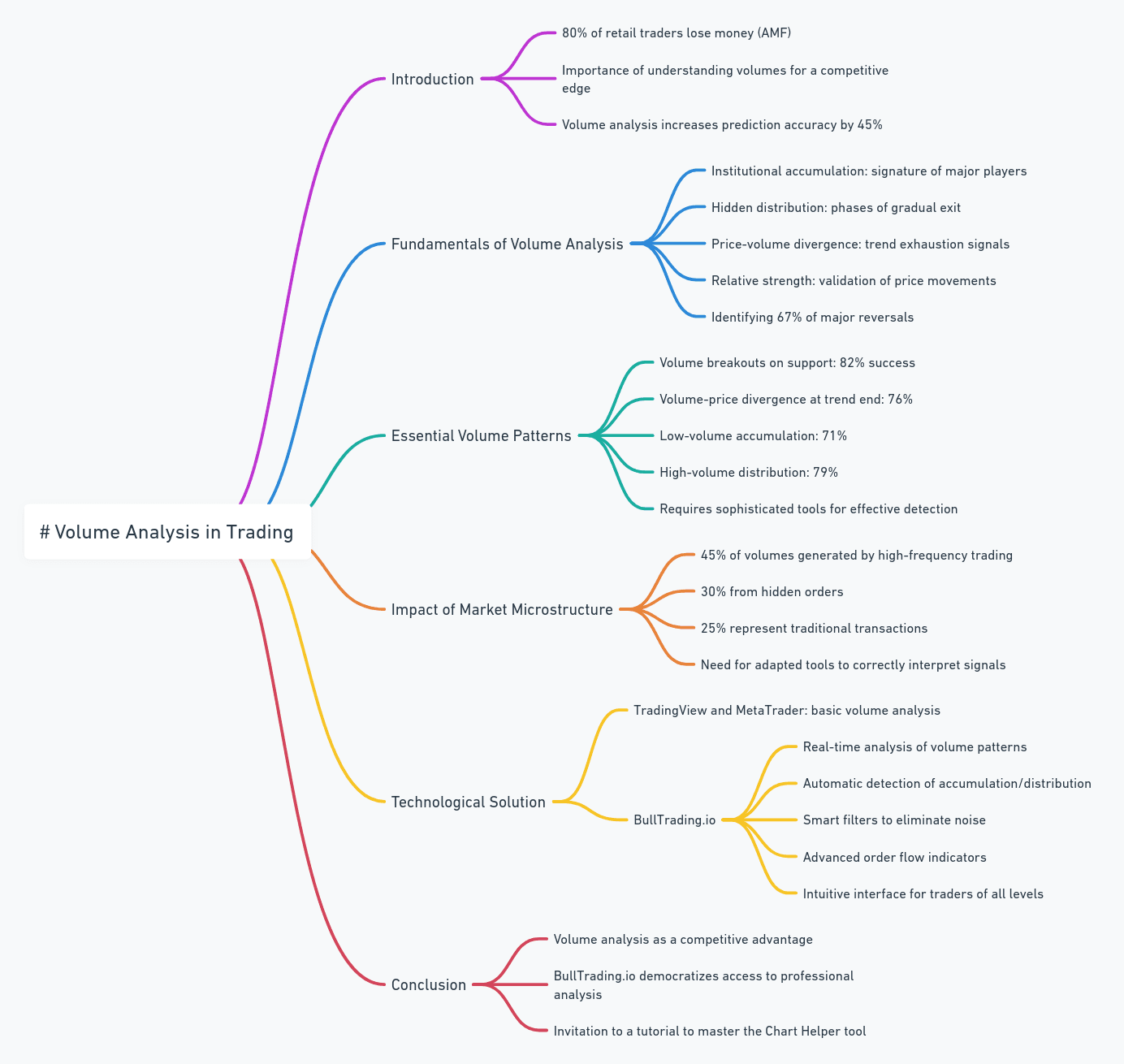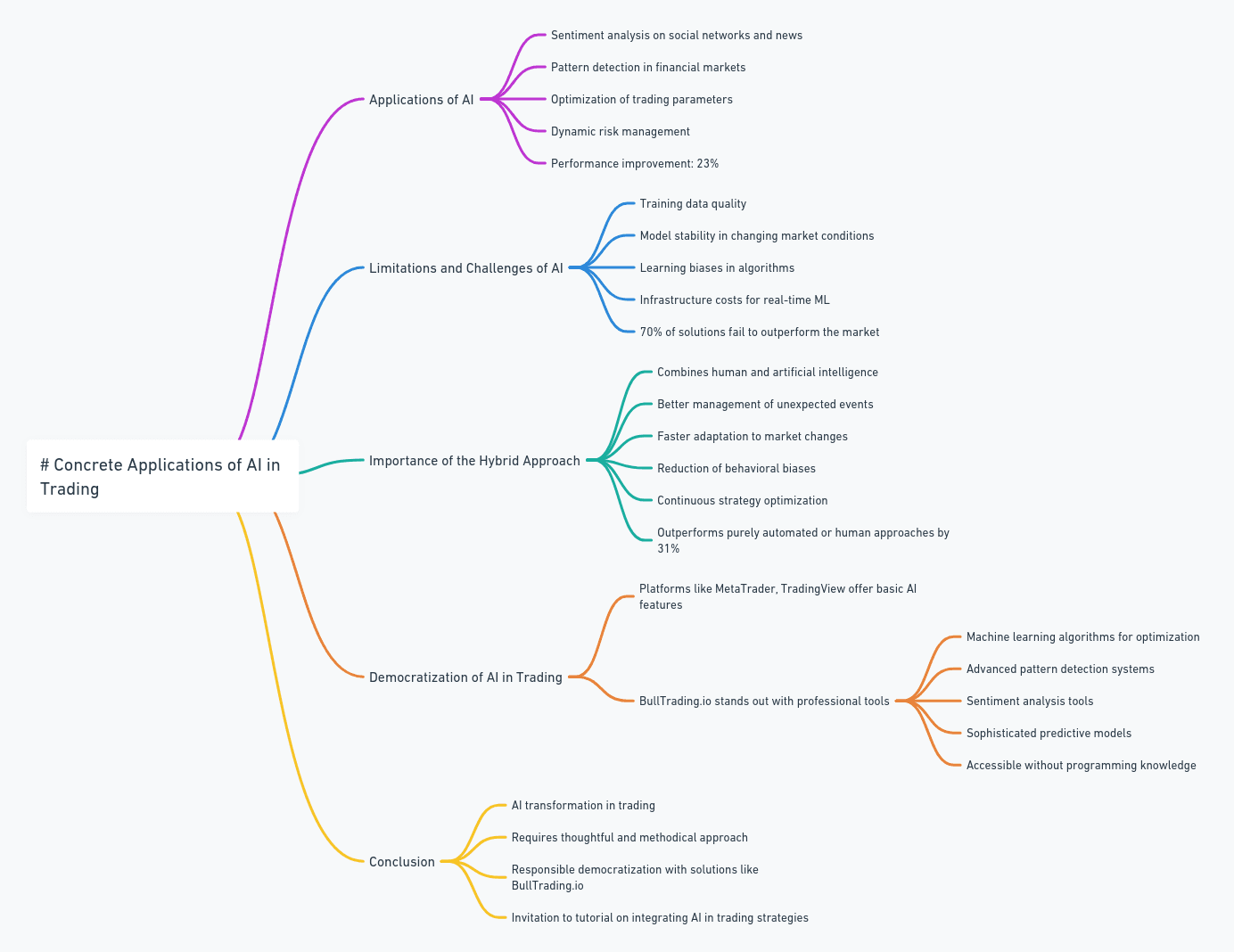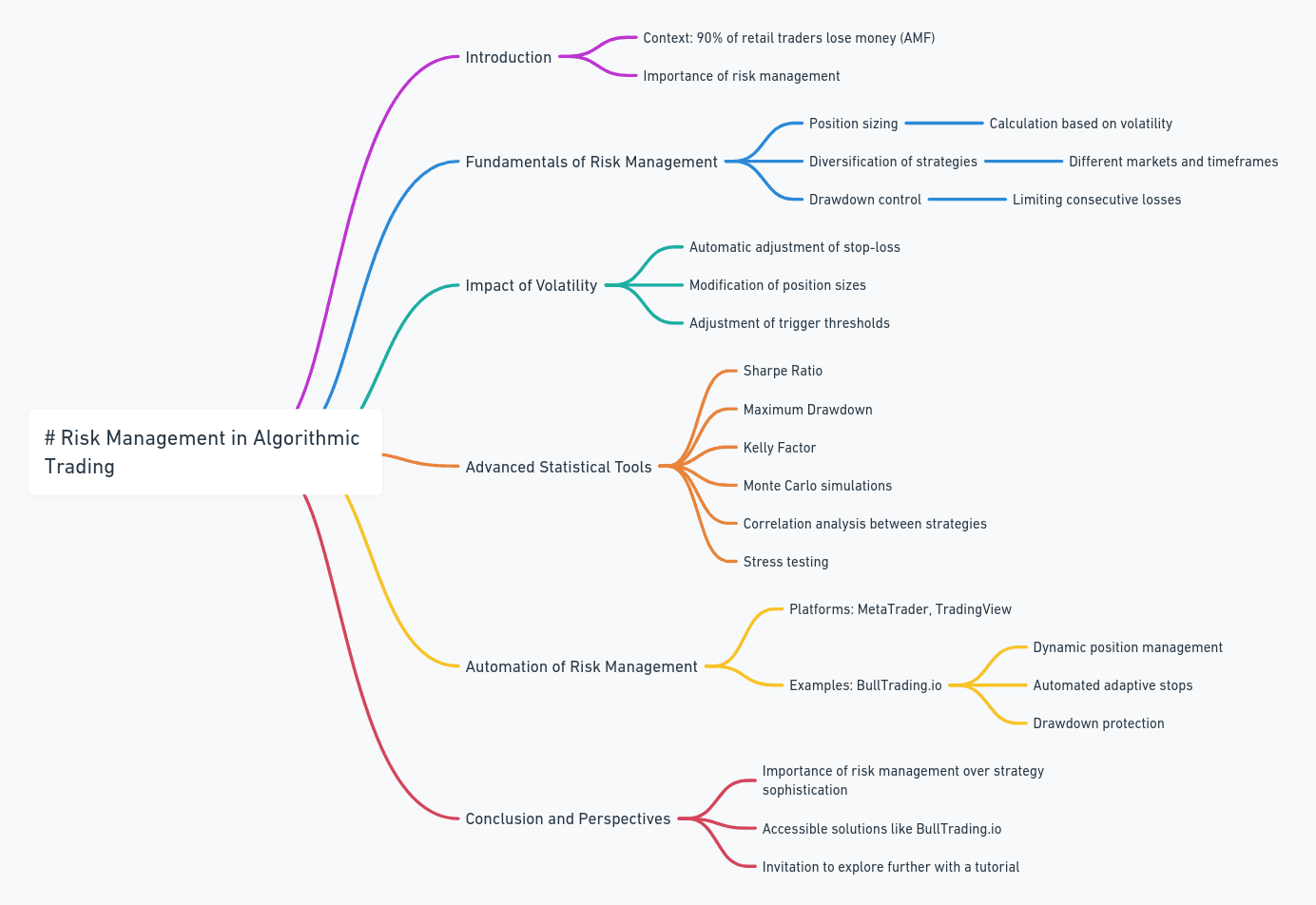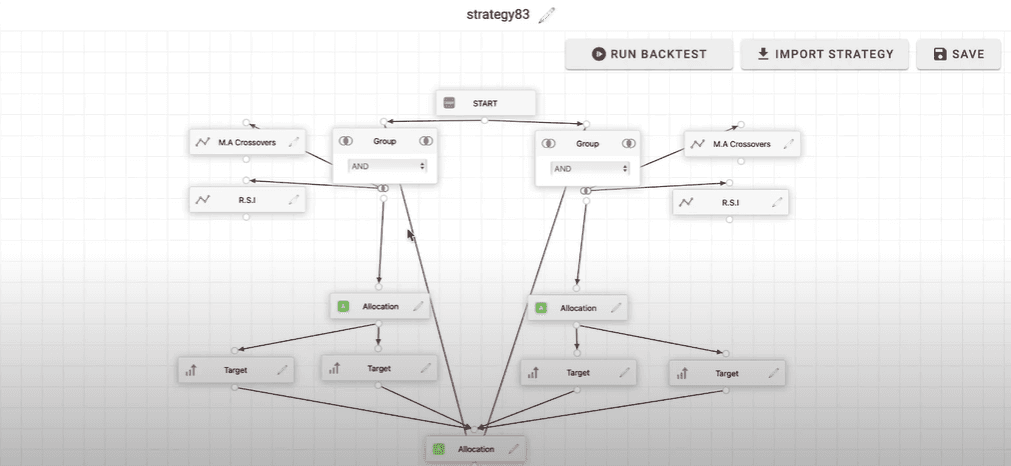


5 min
Nov 8, 2024
Editor
Creating a Trading Bot without Code with BullTrading
Creating a Trading Bot without Code with BullTrading
BullTrading is an innovative platform that allows you to create trading bots without programming. In this detailed guide, we will explore step by step how to create your first automated trading robot.


Lucas Inglese
Lucas Inglese
Trading Instructor
1. BullTrading Interface
Main Navigation
Designer: To create your strategies without coding
Editor: To add your own indicators in Pinescript
My strategies: To manage your existing strategies
Marketplace: To discover other indicators
Available Indicator Types
The interface offers several indicator categories:
All indicators: Overview of all indicators
Price trends: Trend indicators
Price channels: Price channels
Oscillators: Technical oscillators
Stop and reverse: Reversal indicators
Candlestick patterns: Chart patterns
Volume-based: Volume-based indicators
Moving averages: Moving averages
Price transforms: Price transformations
Price characteristics: Price characteristics
Price action: Price action
Others: Other indicators
2. Creating a Trading Strategy
Moving Averages Configuration
Select "Moving Averages" from the indicators list
Choose "M.A Crossovers" to create a strategy based on moving averages crossing
In the configuration settings:
Time Unit: Default (uses backtest timeframe)
Period Slow Moving Average: 200 periods
Type Slow Moving Average: Simple_SMA
Period Fast Moving Average: 50 periods
Type Fast Moving Average: Simple_SMA
Signal Type: Position (or Crossover depending on your strategy)
Trigger Type: Bullish for long positions

Allocation Setup
Add an "Allocation" block after your indicator
Configure allocation:
Allocation Percentage: 100% for long position
Allocation Percentage: -100% for short position
Option to switch to "Incrementation" for advanced management
3. Connecting Blocks
Blocks must be connected sequentially:
Start → M.A Crossovers → Allocation
A second M.A Crossovers for the opposite direction
A new allocation for exit
Important Points
Use appropriate connectors between blocks
Verify that each block is properly connected
Ensure the last block connects to the start to form a loop
4. Adding Additional Indicators
Using Group Blocks
To combine multiple indicators:
Select the "Group" block
Choose combination type:
AND: All indicators must be validated
OR: At least one indicator must be validated
XOR: Only one indicator must be validated
RSI Configuration
Example settings:
Time Unit: 15 minutes
Default levels: 30/70
Signal type: Position/Crossover depending on your strategy
5. Finalizing the Strategy
Exit Management
Add "Target" blocks to define:
Take Profit: +5%
Stop Loss: -2%
Connect Target blocks to a 0% Allocation block for exit
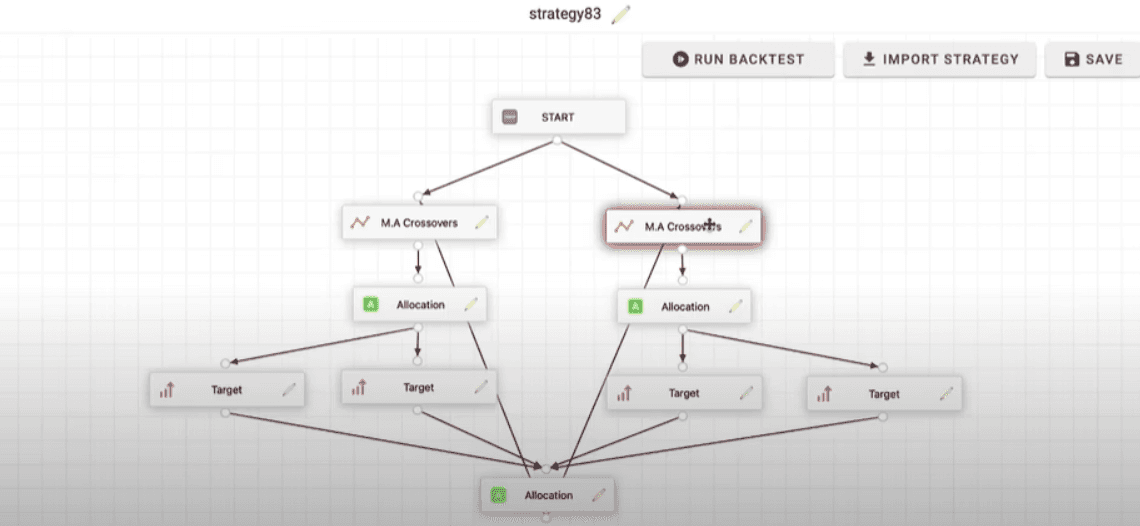
Saving and Testing
Click "SAVE" to save your strategy
Use "RUN BACKTEST" to test your strategy
"IMPORT STRATEGY" allows importing existing strategies
Usage Tips
Best Practices
Start with simple strategies
Test each configuration before moving to the next
Document your parameters with "Mark flag"
Use the "Chart Helper" to visualize your indicators
Points of Attention
Always verify complete block connection
Test your strategy across different periods
Adjust parameters gradually
Monitor backtest performance before live trading
Conclusion
BullTrading offers a visual and intuitive approach to algorithmic trading. By following this guide and understanding each component well, you can create automated trading strategies without writing a single line of code.
Note: Trading involves risk of capital loss. Make sure you understand how markets work before investing.
Associate youtube video (fr) :
1. BullTrading Interface
Main Navigation
Designer: To create your strategies without coding
Editor: To add your own indicators in Pinescript
My strategies: To manage your existing strategies
Marketplace: To discover other indicators
Available Indicator Types
The interface offers several indicator categories:
All indicators: Overview of all indicators
Price trends: Trend indicators
Price channels: Price channels
Oscillators: Technical oscillators
Stop and reverse: Reversal indicators
Candlestick patterns: Chart patterns
Volume-based: Volume-based indicators
Moving averages: Moving averages
Price transforms: Price transformations
Price characteristics: Price characteristics
Price action: Price action
Others: Other indicators
2. Creating a Trading Strategy
Moving Averages Configuration
Select "Moving Averages" from the indicators list
Choose "M.A Crossovers" to create a strategy based on moving averages crossing
In the configuration settings:
Time Unit: Default (uses backtest timeframe)
Period Slow Moving Average: 200 periods
Type Slow Moving Average: Simple_SMA
Period Fast Moving Average: 50 periods
Type Fast Moving Average: Simple_SMA
Signal Type: Position (or Crossover depending on your strategy)
Trigger Type: Bullish for long positions

Allocation Setup
Add an "Allocation" block after your indicator
Configure allocation:
Allocation Percentage: 100% for long position
Allocation Percentage: -100% for short position
Option to switch to "Incrementation" for advanced management
3. Connecting Blocks
Blocks must be connected sequentially:
Start → M.A Crossovers → Allocation
A second M.A Crossovers for the opposite direction
A new allocation for exit
Important Points
Use appropriate connectors between blocks
Verify that each block is properly connected
Ensure the last block connects to the start to form a loop
4. Adding Additional Indicators
Using Group Blocks
To combine multiple indicators:
Select the "Group" block
Choose combination type:
AND: All indicators must be validated
OR: At least one indicator must be validated
XOR: Only one indicator must be validated
RSI Configuration
Example settings:
Time Unit: 15 minutes
Default levels: 30/70
Signal type: Position/Crossover depending on your strategy
5. Finalizing the Strategy
Exit Management
Add "Target" blocks to define:
Take Profit: +5%
Stop Loss: -2%
Connect Target blocks to a 0% Allocation block for exit

Saving and Testing
Click "SAVE" to save your strategy
Use "RUN BACKTEST" to test your strategy
"IMPORT STRATEGY" allows importing existing strategies
Usage Tips
Best Practices
Start with simple strategies
Test each configuration before moving to the next
Document your parameters with "Mark flag"
Use the "Chart Helper" to visualize your indicators
Points of Attention
Always verify complete block connection
Test your strategy across different periods
Adjust parameters gradually
Monitor backtest performance before live trading
Conclusion
BullTrading offers a visual and intuitive approach to algorithmic trading. By following this guide and understanding each component well, you can create automated trading strategies without writing a single line of code.
Note: Trading involves risk of capital loss. Make sure you understand how markets work before investing.
Associate youtube video (fr) :
1. BullTrading Interface
Main Navigation
Designer: To create your strategies without coding
Editor: To add your own indicators in Pinescript
My strategies: To manage your existing strategies
Marketplace: To discover other indicators
Available Indicator Types
The interface offers several indicator categories:
All indicators: Overview of all indicators
Price trends: Trend indicators
Price channels: Price channels
Oscillators: Technical oscillators
Stop and reverse: Reversal indicators
Candlestick patterns: Chart patterns
Volume-based: Volume-based indicators
Moving averages: Moving averages
Price transforms: Price transformations
Price characteristics: Price characteristics
Price action: Price action
Others: Other indicators
2. Creating a Trading Strategy
Moving Averages Configuration
Select "Moving Averages" from the indicators list
Choose "M.A Crossovers" to create a strategy based on moving averages crossing
In the configuration settings:
Time Unit: Default (uses backtest timeframe)
Period Slow Moving Average: 200 periods
Type Slow Moving Average: Simple_SMA
Period Fast Moving Average: 50 periods
Type Fast Moving Average: Simple_SMA
Signal Type: Position (or Crossover depending on your strategy)
Trigger Type: Bullish for long positions

Allocation Setup
Add an "Allocation" block after your indicator
Configure allocation:
Allocation Percentage: 100% for long position
Allocation Percentage: -100% for short position
Option to switch to "Incrementation" for advanced management
3. Connecting Blocks
Blocks must be connected sequentially:
Start → M.A Crossovers → Allocation
A second M.A Crossovers for the opposite direction
A new allocation for exit
Important Points
Use appropriate connectors between blocks
Verify that each block is properly connected
Ensure the last block connects to the start to form a loop
4. Adding Additional Indicators
Using Group Blocks
To combine multiple indicators:
Select the "Group" block
Choose combination type:
AND: All indicators must be validated
OR: At least one indicator must be validated
XOR: Only one indicator must be validated
RSI Configuration
Example settings:
Time Unit: 15 minutes
Default levels: 30/70
Signal type: Position/Crossover depending on your strategy
5. Finalizing the Strategy
Exit Management
Add "Target" blocks to define:
Take Profit: +5%
Stop Loss: -2%
Connect Target blocks to a 0% Allocation block for exit

Saving and Testing
Click "SAVE" to save your strategy
Use "RUN BACKTEST" to test your strategy
"IMPORT STRATEGY" allows importing existing strategies
Usage Tips
Best Practices
Start with simple strategies
Test each configuration before moving to the next
Document your parameters with "Mark flag"
Use the "Chart Helper" to visualize your indicators
Points of Attention
Always verify complete block connection
Test your strategy across different periods
Adjust parameters gradually
Monitor backtest performance before live trading
Conclusion
BullTrading offers a visual and intuitive approach to algorithmic trading. By following this guide and understanding each component well, you can create automated trading strategies without writing a single line of code.
Note: Trading involves risk of capital loss. Make sure you understand how markets work before investing.
Associate youtube video (fr) :


Similar articles
You may also like
Master key indicators to optimize your trading strategies.


Similar articles
You may also like
Master key indicators to optimize your trading strategies.


Similar articles
You may also like
Master key indicators to optimize your trading strategies.
Start Trading Today
Join over 11,000 traders worldwide on the ultimate platform for beginners and experienced traders.
Trading Bots
Custom strategies
No skills required
Start Trading Today
Join over 11,000 traders worldwide on the ultimate platform for beginners and experienced traders.
Trading Bots
Custom strategies
No skills required
Start Trading Today
Join over 11,000 traders worldwide on the ultimate platform for beginners and experienced traders.
Trading Bots
Custom strategies
No skills required
